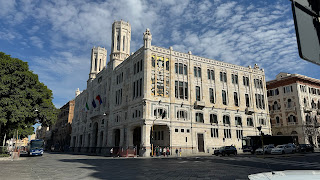Breakfast at Tiffany’s, Tiffany’s Café Calgiari, that is. After, we walk to Via Roma, a bustling thoroughfare along the marina. It’s here we meet Alberto, our Ape (op-AYE, a Vespa with three wheels and a back seat for two additional passengers) driver who’s taking us touring the city today. For the first hour, we zip through the 4 most popular and historic neighborhoods, Castello, Stampace, Villanova and La Marina.
We learn about the history and the current state of this half a million resident town, getting some genuine insight about living here as we learn a bit about Alberto himself. Some takeaways:
- The residents love it here because it’s big enough to be metropolitan and cultural, but small enough to be friendly and low crime.
- Getting a job is really, really difficult, but there is opportunity. Alberto’s dad was a nuclear physicist who taught here at the university. Alberto is educated, but couldn’t find a decent gig (or prefers not to do a typical 9 to five, hard to tell), so he invented one for himself. He now owns and operates the Ape tour business, owns a few Airbnb properties and has a couple other things going on the side.
- The people here like the ability to get into the countryside within half an hour for some escapism.
The second hour is spent putting out to Poetto beach, the 4-mile
stretch of city seaside. We start at the
lighthouse on the northern end for some panoramic views of the cityscape. Next, we drive the entire length of Poetto and
Alberto gives us his take on the clubs as we drive by each one. He also discusses the unfortunate soviet
influenced architecture, sad state of some of the structures and the
exceedingly slow pace of updating and change the local government has
allowed. This place is a huge draw for
international travelers and Sardinian daytrippers alike, and it’s busy even on
this cool pre-summer day.
Finally we arrive at the salt flats past the end of the beach road. Here, right beside the busy city causeway, are an extensive network of shallow pools that were once used in the production of salt covering many square miles. Through a series of gates and sluices, the pools would be flooded with seawater, the water would be allowed to evaporate, the remaining salt then harvested for sale. Now out of operation, the ponds are permanently filled with about a foot of sea water, becoming another important habitat and nesting ground for Sardinia’s flamingo population.
The tour ends and we say our goodbyes to Alberto, but not
before getting a few dining tips (more on that later). We lunch at Taccas in the Stampace (stam-PACH-aye)
neighborhood, especially because they serve a traditional regional lasagna called
Su Mazzamurru, made from layers of Carasau flatbread in lieu of traditional noodle
sheets. Suffice to say, I will be reverse
engineering this dish when I get back home.
We wander up to the Castello area to take in the Archaeology Museum to see the ancient Giant Statues. The museum was well designed and interesting, and we especially enjoyed the delicate gold jewelry and bronze statues from thousands of years ago. The Giant (there was only one) apparently wrote his own publicity as he only stood about 6 feet high. We got one last bit of living history lesson (and living with history lesson) walking back to our flat, passing one very old building that had succumbed to the centuries and had been reinforced awaiting repair.
One of the other topics we talked about with Alberto during
our tour was local food. Although this
is an island, most Sardinian meals are meat based. Of course beef and pork, but they have a
special affinity for goat and rabbit and horse.
Yes, horse. Mister Ed, Secretariat,
Silver, Trigger and My Little Pony. Horse. Readers of this blog may know that I try to order
the weird local dishes when I travel, and I know I’m gonna lose a few friends
over this one. We head to La Cantina, a
hole in the wall near Alberto’s home in the Marina District, and a place where he
recommends for no-frill local fare. We
walk in and none of the staff speaks a word of English, so I tech-nerd my way
through. First a picture of me, Mandy
and Alberto taken earlier today by way of introduction. They literally applaud when they see the image. With the help of Google Translate, I order
the horse steak and Mandy gets the pork chop.
How was it, you may ask? It was
OK. Alberto recommended “to order it
blood”, which is how rare I enjoy a ribeye, but I chicken out and go medium
rare. It’s very, very lean, so it’s cut
thin and I understand the recommendation not to overcook it. It was simply grilled, so I needed to season with
salt and pepper as the server recommended.
The taste was slightly richer than a New York Strip and it was a bit
tough because I went off script. Would I
order it again? Probably, ney. But I cannot wait until the next time I’m
served a bad cut of meat in a restaurant.
I’m going to find the chef and use my new favorite review… “I’ve
literally had better horse then this.”
No frills local dining doesn’t take much time, and we’re not
ready to call it a night, so we head to Villanova. Spanish for New Home, it’s the most
beautiful of the areas we saw today. There’s
a charming square, with a few charming cafes, populated with charming locals
sipping drinks and chatting in low voices.
We slip in, order and spend the rest of the evening pointing at nearby
homes and imagining what it would be like to live here for a few years.



































No comments:
Post a Comment